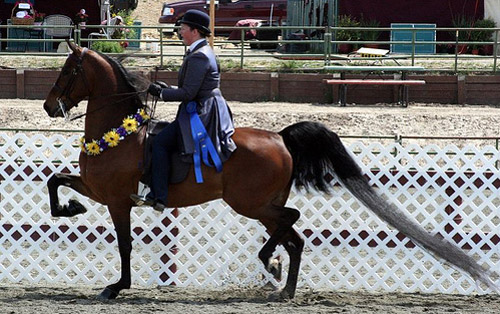
Gaited animals possess a very different way of moving than the majority of domestic breeds. They are prized as riding horses over distances due to their smooth gaits
What Is A Gaited Breed?
Gaited breeds have a natural tendency towards smooth, four-beat gaits. There are a variety of names for these medium-speed gaits, however they are collectively referred to as ambling gaits. This is a hereditary trait and and generally only found in certain breeds. The list below is hardly complete, but includes a large chunk of the gaited breeds.
Aegidienberger | American Saddlebred | American Walking Pony | Campolina | Icelandic Horse | Kentucky Mountain Saddle Horse | Mangalarga Marchador | MO Fox Trotter | Paso Fino | Peruvian Paso | Racking Horse | Sini | Spotted Saddle Horse | Tennessee Walking Horse | Virginia Highlander

Not all members of ‘gaited’ breeds will gait & some of the gaited ones may trot as well.
The Riding Horse
It is not really known where the gaited breeds originated, but it is thought they may come from the far East. Many Iberian breeds are disposed to gaited movement as are a wide variety of the South American and Southern North American breeds they spawned. Appreciated for their smooth ride, they became the quintessential plantation riding horse.

Not just smooth to ride, gaited breeds are known for their docile and willing temperament.
Modern Gaited Breeds
Although hardly needed for long distance travel or plantation work these days, gaited breeds are still popular mounts. Smoother gaits are great for endurance, trail riding and any number of equestrian sports.
Horse Types
As if horse breeds weren’t confusing enough, there are a variety of types as well. Typing is a much older form of classification and stems mainly from the geography & climate of the animal’s native land. Be sure to check out the list of all the different horse types and keep checking back for more in-depth info about each one.